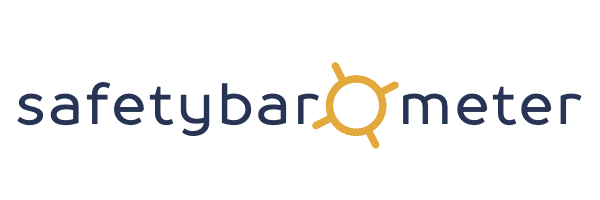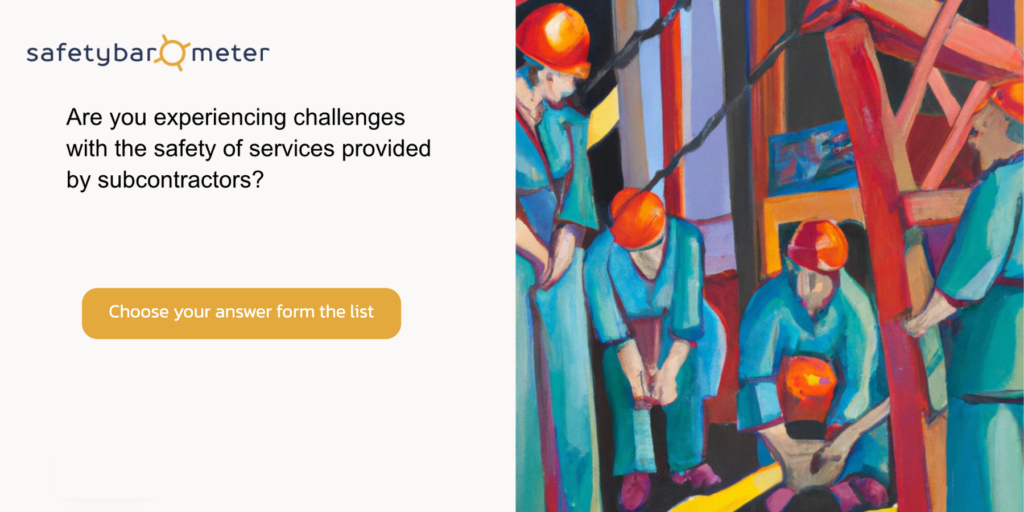
Navigating Challenges in Subcontracted Service Safety
The industrial manufacturing sector is a complicated domain. The outsourcing of services creates an additional layer of complexity. Managing safety issues presents multifaceted challenges.
Today we talk about the varying degrees of complexity of outsourced services in the industrial sector. We offer valuable insights based on real-world examples.

A closer look at the frequency of challenges.
Security challenges in outsourced services have a broad spectrum and include both expected and unforeseen problems. It is essential to assess the frequency of these challenges within your own operational context:
- Often: Safety challenges are a recurring occurrence, necessitating constant attention and mitigation efforts.
- Sometimes: Challenges arise periodically, requiring attention and response as they unfold.
- Rarely: Challenges occur infrequently, making them more of an exception than a rule.
- Never: Safety challenges related to subcontracted services have never been a concern in your operations.
Subcontracted Service Safety Challenges
1. Frequent Challenges
When challenges surface often, it’s indicative of a systemic issue. It may point toward a disconnect between subcontractors and your safety protocols. Addressing these recurrent challenges requires a deeper analysis of the root causes and perhaps an overhaul of communication and coordination mechanisms.
- Inadequate Training: Subcontracted workers may not receive comprehensive training on the specific safety protocols and procedures of the host organization. This can lead to frequent safety violations or incidents.
- Communication Gaps: Lack of effective communication between subcontractors and the host organization can result in misunderstandings about safety expectations, leading to recurrent safety issues.
Example: If subcontractors do not receive clear instructions on the handling of hazardous chemicals, it could lead to recurrent safety issues, including chemical spills or exposure incidents. - Equipment Maintenance: Frequent breakdowns or malfunctions of subcontracted equipment due to inadequate maintenance can pose safety risks in industrial settings.
Example: In an automotive assembly plant, the recurring equipment failures might compromise the structural integrity of welds, potentially leading to safety incidents or product defects. - Compliance Issues: Subcontractors may not consistently adhere to industry standards and regulations, leading to recurring safety compliance problems.
Example: In the pharmaceutical sector, subcontractors involved in packaging and labeling may occasionally fail to consistently adhere to industry standards and regulations. Such compliance issues can result in recurring safety compliance problems, particularly when it comes to packaging medications with strict regulatory requirements. - High Turnover: Frequent turnover among subcontracted workers can disrupt the continuity of safety procedures, as new personnel may not be adequately familiarized with safety protocols.
Example: In an electronics manufacturing facility, this could lead to recurring safety incidents related to electrostatic discharge or mishandling of sensitive electronic components. - Resource Constraints: Subcontractors may face resource limitations, such as insufficient safety equipment or personnel, which can result in recurring safety challenges.
2. Occasional Challenges
Intermittent challenges can emerge due to unique circumstances. These might be related to the nature of the services, the unfamiliarity of subcontractors with your safety procedures, or specific project complexities. Such challenges warrant a responsive and adaptive approach, with a focus on consistent monitoring.
- Project-Specific Hazards: Certain projects may involve unique safety hazards that are not commonly encountered. Subcontractors may face occasional challenges in adapting to these specialized risks, which may require additional safety measures.
Example: A construction project in a confined urban space may require subcontractors to navigate intricate scaffolding structures, which are uncommon in their typical work. This presents an occasional challenge due to the unfamiliarity with such conditions. - Complex Safety Procedures: Some projects may demand intricate safety procedures or protocols that subcontractors are not accustomed to. The occasional challenges stem from the need to understand and implement these procedures correctly.
Example: In a chemical manufacturing facility, subcontracted workers may occasionally struggle with the complex safety protocols for handling hazardous materials, resulting in occasional safety lapses. - Resource Constraints: Occasional challenges may arise when subcontractors lack access to specific safety equipment or resources required for a particular project. This can lead to temporary safety gaps.
Example: Subcontracted crane operators may occasionally encounter challenges due to the unavailability of specialized crane safety gear required for specific heavy lifting tasks. - Intermittent Weather Factors: Some safety challenges are seasonal or weather-dependent. Subcontractors may encounter occasional issues related to adverse weather conditions, such as strong winds or heavy rain, impacting safety protocols.
Example: Roofing subcontractors may face occasional safety challenges during stormy weather, which can make working at heights more hazardous. - Changes in Project Scope: Occasional challenges can also stem from changes in project scope, which may introduce new safety considerations that subcontractors need to adapt to quickly.
Example: A construction project may expand to include demolition work, requiring subcontractors to adjust to the added safety precautions associated with demolition activities.
3. Rare Challenges
Challenges that arise rarely could be a testament to the effectiveness of your safety communication and management strategies. However, it’s important not to be complacent. Even isolated incidents can have significant consequences, so staying vigilant is crucial!
- Unforeseen Technological Failures: Rare challenges may emerge when highly specialized equipment or technology used by subcontractors experiences infrequent, unexpected failures. These incidents are rare due to stringent maintenance procedures and high-quality equipment but can have substantial consequences when they do occur.
Example: In a semiconductor manufacturing facility, a rare challenge may involve the sudden failure of a specialized cleanroom filtration system, leading to potential contamination risks. - Extreme Environmental Events: Subcontracted services may encounter rare challenges related to extreme environmental events, such as earthquakes or floods, which are infrequent but can disrupt safety protocols and normal operations.
Example: In a coastal chemical processing plant, a rare challenge could be a tsunami threat, which may require unique safety procedures not typically practiced. - Epidemic/Pandemic Outbreaks: While the occurrence of epidemic or pandemic outbreaks is rare, they can introduce unique safety challenges related to health and biosecurity. These challenges require specific response plans, which may not be frequently implemented.
Example: During a rare pandemic event, subcontracted healthcare providers may face exceptional challenges related to personal protective equipment (PPE) shortages and infection control measures. - Uncommon Regulatory Changes: Rare challenges can stem from infrequent changes in regulations or standards governing specific industries, necessitating a thorough understanding of new compliance requirements.
Example: In the nuclear energy sector, rare challenges may arise when international safety standards for reactor operations are updated, requiring comprehensive adjustments in safety procedures. - Vendor or Supplier Disruptions: Rare challenges may emerge when subcontractors rely on specialized vendors or suppliers whose operations are rarely disrupted but can impact safety protocols when they are.
Example: A rare challenge in automotive manufacturing subcontracting might involve a sudden interruption in the supply chain for critical safety-critical components, leading to production delays.


